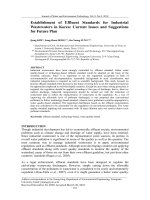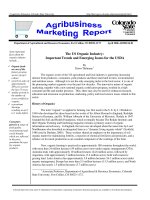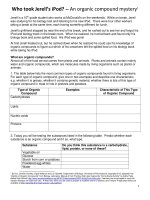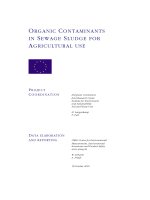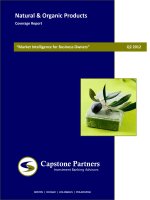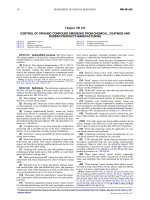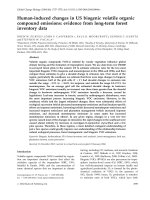National Volatile Organic Compound Emission Standards for Architectural Coatings ppt
Bạn đang xem bản rút gọn của tài liệu. Xem và tải ngay bản đầy đủ của tài liệu tại đây (778.18 KB, 222 trang )
EP
A
O
f
f
i
c
e
o
f
A
i
r
Q
u
a
l
i
t
y
Pla
nn
in
g
a
n
d
S
ta
nd
a
rd
s
A
i
r
C
l
ea
n
United States Office of Air Quality EPA-453/R-99-003
Environmental Protection Planning and Standards July 1999
Agency Research Triangle Park, NC 27711 />183e/aim/aimpg.html
Air
SMALL ENTITY COMPLIANCE GUIDE
National Volatile Organic Compound
Emission Standards for Architectural
Coatings
Small Entity Compliance Guide
2
Disclaimer
This guide was prepared pursuant to section 212 of the Small Business
Regulatory Enforcement Act of 1996 (SBREFA), Public Law 104-121. This guide is
intended solely to help regulated entities comply with the published national regulation,
"National Volatile Organic Compound Emission Standards for Architectural Coatings”
(
Federal Register
, Vol. 63, No. 176, pages 48848 - 48887, September 11, 1998,
included here in Appendix A). Technical corrections were published on June 30, 1999
(Federal Register, Vol. 64, No. 125, pages 34997-35002, included here in Appendix A.)
This guide is not intended to replace the regulation and corrections and may not
cover all parts of the regulation and corrections. Final authority rests solely with the
regulation and corrections to the regulation. However, in any civil or administrative
action against a small business, small government, or small non-profit organization for a
violation of the architectural coatings regulation, the content of this guide may be
considered as evidence of the reasonableness or appropriateness of proposed fines,
penalties or damages.
Acknowledgments
This document was prepared by the Office of Air Quality Planning and Standards
(OAQPS), U.S. Environmental Protection Agency and approved for publication. This
document was provided for review to State Small Business Assistance Programs, the
Small Business Administration, the National Paint and Coatings Association, and a
number of small business owners.
Small Entity Compliance Guide
3
CONTENTS
Section
1.0 INTRODUCTION 7
1.1 Who should use this guide? 8
1.2 What does the guide cover? 8
1.3 How do I use the guide? 9
1.4 How do I obtain a complete copy of the regulation? 10
2.0 WHAT DOES THE REGULATION REQUIRE? 11
2.1 What environmental or human health issues does this regulation
address? 11
2.2 Why is it important to regulate architectural coatings? 13
2.3 Summary of the architectural coatings regulation 14
2.4 How do I demonstrate compliance? 19
2.5 Compliance timetable 20
2.6 How does the national architectural coatings regulation relate to State and
local requirements? 21
3.0 STEP-BY-STEP PROCEDURES FOR COMPLIANCE WITH
THE REGULATION 23
3.1 How do I determine if I am subject to the regulation? 24
3.1.1 Am I a manufacturer? 25
3.1.2 Am I an importer? 26
3.1.3 Is the coating that I manufacture or import an architectural
coating? 27
3.1.4 Is the architectural coating that I manufacture or import exempt
from the regulation? 29
3.1.5 How does the regulation apply to me if I am a toll manufacturer or a
private-label manufacturer? 30
3.2 What requirements must I meet? 37
3.3 When do I need to comply? 39
3.4 What do I need to do to comply? 40
3.5 How do I determine the category for my coating? 41
3.6 How do I determine the VOC content of my coating? 42
3.7 What must I do if all of my coatings meet the VOC content limits? 49
3.8 How can I use the tonnage exemption? 51
3.9 How can I use the exceedance fee? 57
3.10 How can I use more than one compliance option? 64
3.11 What reports and records are required? 71
3.12 How do I comply with the container labeling requirements? 76
3.13 How does the regulation affect me if I apply traffic markings? 78
Small Entity Compliance Guide
4
4.0 OTHER QUESTIONS AND ANSWERS 81
4.1 How might I conduct a self-audit to help me evaluate whether I am in
compliance with this regulation? 81
4.2 If I am subject to this regulation, do I have to obtain a Federal
operating permit? 84
4.3 What are the implications for my existing operating permits? 84
4.4 What is pollution prevention and how can it affect my operations? . . . 85
4.5 Are there opportunities for flexibility or waivers? 86
4.6 Where do I go for further assistance? 86
5.0 THE COMPLIANCE ASSURANCE PROCESS 87
5.1 How will EPA determine compliance? 87
5.2 If I discover a violation, how can I work with the EPA to correct it? . . . 88
5.3 If EPA discovers a violation, what might be its response? 89
5.4 What is the legal status of this guide? 90
Small Entity Compliance Guide
5
FIGURES
Figure
1 Volatile organic compound (VOC) content limits for architectural
coatings 17
2 State and local architectural coatings regulations 22
3 Who is responsible when more than one coating company is
involved in manufacturing a coating? 31
4 What must I do if all of my coatings meet the VOC content limits? 50
5 How can I use the tonnage exemption? 53
6 How can I use the exceedance fee? 58
7 Self-audit checklist for determining compliance 82
Small Entity Compliance Guide
6
APPENDICES
Appendix A
: Final rule: National Volatile Organic Compound Emission
Standards for Architectural Coatings (40 CFR Part 59, Subpart D,
63 FR 48848, September 11, 1998)
Final rule; corrections and amendments. National Volatile Organic
Compound Emission Standards for Architectural Coatings;
Correction (40 CFR Part 59, Subpart D, 64 FR 34997, June 30,
1999)
Appendix B
: Fact sheets for each architectural coating category, including the
definitions and VOC content limits
Appendix C
: Summary of the exceptions to meeting the most restrictive coating
category VOC content limit
Appendix D
: Organic compounds that have been exempted from EPA’s
definition of a VOC in 40 CFR 51.100
Appendix E
: EPA’s Test Method 24: Determination of volatile matter content,
water content, density, volume solids, and weight solids of surface
coatings
Appendix F
: When do I include or exclude water, exempt compounds, and
colorant from my coating VOC and volume calculations?
Appendix G
: EPA Regional Office addresses for information and sending
notifications, reports, and fees
Appendix H
: Worksheets for estimating and computing total mass of VOC for
the tonnage exemption and calculating exceedance fees
Appendix I
: Initial notification report template
Appendix J
: Contacts and resources
Appendix K
: Glossary
Appendix L
: Questionnaire: How useful was this guide?
1.0 Introduction
7
1.0 INTRODUCTION
After reading this introduction, you should know whether you need to use
this guide, what this guide covers, and where to get the latest information on
the regulation.
The U.S. Environmental Protection Agency (EPA) published the regulation
entitled “National Volatile Organic Compound Emission Standards for Architectural
Coatings” (
Federal Register
, Vol. 63, No. 176, pages 48848 - 48887) on September 11,
1998 under authority of Section 183(e) of the Clean Air Act. This guide explains how to
tell if you are subject to the regulation and what to do if you are required to comply.
The EPA published this document as a compliance guide for small entities, as
required by the Small Business Regulatory Enforcement Fairness Act of 1996. As you
use the guide, you should know that the information in this guide was written and
published in July 1999. The EPA published technical corrections to the architectural
coatings final regulation. The technical corrections were published in the Federal
Register on June 30, 1999 (64 FR 34997). This guide incorporates the regulation
corrections, which are noted with an asterisk (*) and a footnote to explain the correction.
You can determine whether EPA has published further corrections to the regulation or
revised the information in this guide by checking the architectural coatings web site at:
/>The regulation applies to manufacturers and
importers of architectural coatings—not to
distributors or users. An architectural coating is a
coating recommended for field application to
stationary structures, their appurtenances, to
portable buildings, to pavements or to curbs.
The Office of Federal Register (OFR) tracks whether any part of the Code of
Federal Regulations (CFR) changed. To see if EPA has published changes to this
1.0 Introduction
8
regulation (40 CFR part 59, subpart D), browse the OFR list of CFR sections affected at
If you do not have access to the
Internet, you can contact EPA’s Clean Air Technology Center (CATC) at 919-541-0800.
1.1 Who should use this guide?
If you manufacture or import an architectural coating for sale or distribution in the
United States, then you should use this guide to help you understand the requirements
you are subject to under EPA’s architectural coatings national regulation. As the
manufacturer or importer of an architectural coating, you may have to meet certain
requirements limiting the amount of pollutants (i.e., volatile organic compounds) in the
products that you manufacture or import on or after September 13, 1999. If you apply
traffic marking coatings, you are not subject to the regulation, but you should read
section 3.13 of this guide to determine how you may be affected indirectly.
The Small Business Regulatory Enforcement Act (SBREFA) requires the EPA to
prepare this compliance guide to help small businesses comply with the regulation.
The regulation has the same requirements for all affected manufacturers and importers
regardless of the size of the company. Therefore, this guide is also helpful for large
businesses that must comply and to government staff who must implement and enforce
the regulation.
1.2 What does the guide cover?
The purpose of this guide is to help small entities and others affected by the
architectural coatings regulation comply with the regulation. This guide answers the
following questions:
& Why is the architectural coatings regulation important?
& Am I subject to the architectural coatings regulation?
& What must I do to comply with the architectural coatings regulation?
1.0 Introduction
9
1.3 How do I use the guide?
This guide is organized into 5 major sections and 12 appendices.
&
Section 1
introduces you to this guide and the architectural coatings regulation.
You should be able to determine if you are affected by the architectural coatings
regulation, and therefore, whether you need to use this guide.
&
Section 2
provides an overview of the regulatory requirements. This section
explains the environmental and health issues that this regulation addresses.
Section 2 also explains how EPA’s national architectural coatings regulation
relates to other architectural coating regulations at the State and local levels.
&
Section 3
gives step-by-step procedures for determining if you are subject to the
regulation and how to demonstrate compliance.
&
Section 4
covers facility-specific questions regarding topics such as self-audits
and existing air permits.
&
Section 5
discusses how the EPA will determine compliance and how the EPA
will enforce the regulation.
The appendices of this guide contain tools and information that will be useful to
you in complying with the architectural coatings regulation.
Regulation provisions are cited using brackets, i.e., [§ 59.400] so you can cross
reference the regulation if necessary.
1.0 Introduction
10
1.4 How do I obtain a complete copy of the regulation?
A complete copy of the regulation and technical corrections is included in
Appendix A. The National Volatile Organic Compound Emission Standards for
Architectural Coatings (40 CFR part 59, Subpart D) was published in the
Federal
Register
, Vol. 63, No. 176, pages 48848 - 48887 on September 11, 1998. The
technical corrections were published in the Federal Register, Vol. 64, No. 125,
page 34997 on June 30, 1999. You may also obtain a copy of the regulation and
technical corrections on the Internet at
/>2.0 What does the regulation require?
11
2.0 WHAT DOES THE REGULATION REQUIRE?
After reading section 2, you should understand the benefits of this
regulation, the general requirements of the regulation, compliance dates, and
how this national regulation relates to
State and local architectural coatings
regulations
.
2.1 What environmental or human health issues does this regulation
address?
The architectural coatings regulation is part of an integrated EPA approach to
reduce emissions of volatile organic compounds, or "VOC," which have been
associated with a variety of health and welfare impacts. Section 183(e) of the Clean Air
Act directs EPA to list and schedule for regulation categories of consumer and
commercial products because of their potential VOC emissions. VOC react with
nitrogen oxides (NO ) in the presence of sunlight to form ground-level ozone (a primary
x
component of smog). To protect the public health and welfare, EPA has established
national ambient air quality standards (NAAQS). The NAAQS are a measure of
acceptable and unacceptable levels of certain pollutants across the country. More than
half of the U.S. population lives or works in areas that exceed the national standards for
ozone. In order to reduce national ground-level ozone levels, emissions of VOC and
NO must be reduced.
x
Exposure to ground-level ozone is associated with agricultural crop loss and
damage to forests and ecosystems. Human exposure to ozone primarily affects the
lungs. Exposure to ozone is responsible for reduced exercise performance, increased
susceptibility to respiratory infection, and pulmonary inflammation. When ozone levels
are high, more asthmatics have asthma attacks that require a doctor’s attention or the
use of additional asthma medication.
About one out of every three people in the United States is at a higher risk of
experiencing ozone-related health effects. Four groups of people are particularly
2.1 Health and environmental issues
12
sensitive to ozone: children; adults who are active outdoors; people with respiratory
diseases such as asthma; and people with unusual susceptibility to ozone. These
groups become sensitive to ozone when they are active outdoors because physical
activity (such as jogging or outdoor work) causes people to breathe faster and more
deeply. During activity, ozone penetrates deeper into the parts of the lungs that are
more vulnerable to injury.
Ozone's most perceptible effects on human health are acute respiratory
symptoms such as coughing and painful deep breathing. These acute health effects
are induced by short-term exposures to ozone (observed at concentrations as low as
0.12 parts per million [ppm]), generally while individuals are engaged in moderate or
heavy exertion. Acute health effects also are induced by prolonged exposures to ozone
(observed at concentrations as low as 0.08 ppm), typically while individuals are
engaged in moderate exertion. Moderate exertion levels are more frequently
experienced by individuals than heavy exertion levels.
Exposure to ozone may make it uncomfortable to breathe, causing throat
irritation or more rapid and shallow breathing. Ozone can also inflame and temporarily
damage the lining of the lung. Scientists are concerned that repeated short-term
damage from exposure to ozone may permanently change the lung. For example,
there is concern that repeated ozone impacts on the developing lungs of children may
lead to reduced lung function as adults.
Elevated concentrations of ozone are also associated with adverse welfare
effects. Among the welfare impacts from exposure to ozone are damage to selected
commercial timber species and economic losses for commercially valuable crops, such
as soybeans and cotton. The typical concentration level of ozone found in rural areas
is thought to depress crop yields and cause visible damage to other plant life such as
premature aging and leaf loss.
2.2 Why is it important to regulate architectural coatings?
13
2.2 Why is it important to regulate architectural coatings?
In many States, architectural coatings represent one of the largest identifiable
sources of unregulated VOC emissions. Consequently, EPA and many States consider
the regulation of architectural coatings to be an important component of the overall
approach to reducing those emissions that contribute to excess levels of ozone.
Architectural coating regulations are already in place in a number of States, and
other States may develop regulations in the future. For the companies that market
architectural coatings in different States, trying to fulfill the differing requirements of
State regulations has created administrative, technical, and marketing problems. Both
large and small manufacturers have noted the additional burden associated with
differences in State and local requirements. These industry representatives have noted
that a national regulation would provide some degree of consistency, predictability, and
administrative ease for the industry. For a list of States that have architectural coatings
regulations in place, see Section 2.6.
The architectural coatings standards will reduce
nationwide emissions of VOC by 103,000 megagrams
per year (Mg/yr) (113,500 tons per year [tpy]). These
reductions are from a 1990 "baseline" emissions
estimate and represent a 20 percent reduction in VOC
emissions from architectural coatings
.
2.3 Summary of regulation
14
2.3 Summary of the architectural coatings regulation
The architectural coatings regulation sets VOC content limits for 61 categories of
architectural coatings that are manufactured on or after September 13, 1999 (March 13,
2000 for products subject to the Federal Insecticide, Fungicide, and Rodenticide Act).
The regulation has for and you must comply by
VOC content limits 61 cate
g
ories of architectural choosin
g
one or more of the
coatin
g
s listed in Fi
g
ure 1 followin
g
for coatin
g
s that do not
meet the limits:
reformulate the coatin
g
to
meet the limit
desi
g
nate a limited volume as
exempt usin
g
the tonna
g
e
exemption
pay an annual exceedance fee
on the amount of VOC in
excess of the limit
Labelin
g
requirements each coatin
g
sold or providin
g
specific information on
distributed in the United States each container
Coating categories
. Manufacturers and importers must classify each of their
architectural coatings as belonging to at least one of the categories. The 61 categories
of architectural coatings are listed in Figure 1. Manufacturers and importers should
classify their coatings into categories based on the definitions in the regulation. If a
coating meets the definition of more than one coating category, the manufacturer or
importer must comply with the lowest applicable VOC content limit, unless one of the
specified exceptions applies. Section 3.5 and Appendices B and C of this guide
provide information to help you determine the category and VOC content limit for each
of your coatings. [§§ 59.400, 59.401, 59.402]
VOC content limits
. Manufacturers and importers may either reformulate their
coatings to meet the VOC content limits in Figure 1 or choose to comply by using one of
the compliance options described below. Manufacturers and importers who reformulate
their coatings to meet the VOC content limits in Figure 1, or whose coatings already
meet the limits, are only required to submit an initial report and meet the labeling
requirements. However, manufacturers who choose to comply with the regulation by
using the "tonnage exemption," paying the "exceedance fee," or using the adjusted
2.3 Summary of regulation
15
VOC content of recycled coatings must keep records and submit further reports in
addition to submitting the initial report and meeting the labeling requirements.
[§ 59.402]
Tonnage exemption
. This compliance option allows each manufacturer and
importer to sell or distribute limited quantities of architectural coatings that do not
comply with the VOC content limits and for which no exceedance fee is paid. The
tonnage exemption can be used for multiple products, but the total mass of VOC
allowed under the tonnage exemption is a specified total limit each year. The total
mass of VOC is calculated based on the volume of coatings manufactured or imported
and the total amount of VOC contained in each of the coatings for which an exemption
is claimed. [§ 59.404]
Exceedance fee
. This compliance option is an economic incentive approach
whereby manufacturers and importers may choose to comply with the regulation by
paying an annual fee in lieu of meeting the VOC content limits for their coating
products. The fee is $0.0028 per gram, or approximately $2,500 per ton, of excess
VOC. The fee is calculated using the coating’s amount of VOC in excess of the
applicable VOC content limit and the volume of coating manufactured. The
exceedance fee is paid annually. [§ 59.403]
Labeling
. Each container of architectural coating sold or distributed in the
United States must be clearly labeled with the following information: date of
manufacture (or a date code), recommendations for thinning, and VOC content of the
coating. If the coating is an industrial maintenance coating, then the container must
also display one of the specified statements that indicates the coating is not intended
for general consumer use. If the manufacturer or importer claims a credit for recycled
coatings, then the container must indicate the post-consumer content in percent by
volume. [§ 59.405]
Reporting and recordkeeping
. All manufacturers and importers of affected
coatings must submit an initial report to EPA listing the coating categories from Figure 1
that they manufacture or import. They must also report the locations of their facilities
that produce, package, or repackage architectural coatings in the United States. The
regulation does not require periodic records or reports, unless the manufacturer or
2.3 Summary of regulation
16
importer chooses to use the adjusted VOC content of recycled coatings, pays an
exceedance fee, or uses the tonnage exemption. [§§ 59.407, 59.408]
Recycled coatings
. Manufacturers or importers who recycle post-consumer
coatings into their products may take credit for the recycled coating content and meet
less stringent VOC content limits. [§ 59.406(a)(3)]
If you reformulate your coatings to meet the
VOC content limits, or your coatings already
meet the VOC content limits, then you are
subject to fewer recordkeeping and reporting
requirements than if you use the tonnage
exemption or exceedance fee.
Limits are expressed in grams of VOC per liter of coating
thinned to the manufacturer's maximum recommendation
excluding the volume of any water, exempt compounds, or
colorant added to tint bases, except for low solids stains
and low solids wood preservatives.
2.3 Summary of regulation
17
FIGURE 1. VOLATILE ORGANIC COMPOUND CONTENT LIMITS FOR
ARCHITECTURAL COATINGS
Coating category Grams per liter Pounds per gallon
Antenna coatings 530 4.4
Anti-fouling coatings 450 3.8*
Anti-graffiti coatings 600 5.0
Bituminous coatings and mastics 500 4.2
Bond breakers 600 5.0
Calcimine recoater 475 4.0
Chalkboard resurfacers 450 3.8
Concrete curing compounds 350 2.9
Concrete curing and sealing compounds 700 5.8
Concrete protective coatings 400 3.3
Concrete surface retarders 780 6.5
Conversion varnish 725 6.0
Dry fog coatings 400 3.3
Extreme high durability coatings 800 6.7
Faux finishing/glazing 700 5.8
Fire-retardant/resistive coatings:
Clear 850 7.1
Opaque 450 3.8
Flat coatings:
Exterior 250 2.1
Interior 250 2.1
Floor coatings 400 3.3
Flow coatings 650 5.4
Form release compounds 450 3.8
Graphic arts coatings (sign paints) 500 4.2
Heat reactive coatings 420 3.5
High temperature coatings 650 5.4
Impacted immersion coatings 780 6.5
Industrial maintenance coatings 450 3.8
Lacquers (including lacquer sanding sealers) 680 5.7
Magnesite cement coatings 600 5.0
Mastic texture coatings 300 2.5
Metallic pigmented coatings 500 4.2
Multi-colored coatings 580 4.8
Nonferrous ornamental metal lacquers and surface protectants 870 7.3
Nonflat coatings:
Exterior 380 3.2
Interior 380 3.2
Nuclear coatings 450 3.8
Pretreatment wash primers 780 6.5
2.3 Summary of regulation
Coating category Grams per liter Pounds per gallon
**Regulation correction [§ 59.402(a)], see page 7 for where to get the latest
information. The technical correction notice (Appendix A) clarifies that the EPA will
determine compliance with the VOC content limits in metric units, expressed in grams
of VOC per liter of coating, rather than English units.
18
Primers and undercoaters 350 2.9
Quick-dry coatings:
Enamels 450 3.8
Primers, sealers, and undercoaters 450 3.8
Repair and maintenance thermoplastic coatings 650 5.4
Roof coatings 250 2.1
Rust preventative coatings 400 3.3
Sanding sealers (other than lacquer sanding sealers) 550 4.6
Sealers (including interior clear wood sealers) 400 3.3
Shellacs:
Clear 730 6.1
Opaque 550 4.6
Stains:
Clear and semitransparent 550 4.6
Opaque 350 2.9
Low solids 120 1.0
aa
Stain controllers 720 6.0
Swimming pool coatings 600 5.0
Thermoplastic rubber coatings and mastics 550 4.6
Traffic marking coatings 150 1.3
Varnishes 450 3.8
Waterproofing sealers and treatments 600 5.0
Wood preservatives:
Below ground wood preservatives 550 4.6
Clear and semitransparent 550 4.6
Opaque 350 2.9
Low solids 120 1.0
aa
Zone marking coatings 450 3.8
Units are grams of VOC per liter (pounds of VOC per gallon) of coating, including water and exempt compounds, thinned to
a
the maximum thinning recommended by the manufacturer.
* Regulation correction [Table 1 to Subpart D], see page 7 for where to get the latest information. The correct VOC
content limit for anti-fouling coatings is 450 grams per liter and 3.8 pounds per gallon, rather than 3.3 pounds per gallon.
English units are provided for information
only. Regulation enforcement will be based
on the metric levels. **
2.4 Demonstrating compliance
*Regulation correction [§ 59.402(a)], see page 7 for where to get the latest
information. The technical correction notice (Appendix A) clarifies that the EPA will
determine compliance with the VOC content limits in metric units, expressed in grams
of VOC per liter of coating, rather than English units.
19
2.4 How do I demonstrate compliance?
The regulation does not require an initial compliance test. If your coatings
already meet the VOC content limits or if you reformulate your coatings to meet the
limits, then you must only submit the initial report and comply with the labeling
requirements. Even though the regulation does not require you to keep records or
submit periodic reports if your coatings meet the VOC content limits, you are
responsible for ensuring that your coatings continue to meet the VOC content limits and
you may choose any means to do so. You should consider keeping voluntary records
that show compliance with the regulation. Such records would be helpful to you should
an EPA inspector select one or more of your coatings for a compliance determination.
Your records could document the actions you have taken to comply with the regulation
and could clarify any uncertainties that might otherwise occur.
The EPA will determine compliance with the VOC content limits in metric units*
using EPA Method 24 as the reference method (or an alternative method that would be
approved on a case-by-case basis). The EPA may request at any time that you
conduct a Method 24 test to demonstrate compliance. See Appendix E of this guide for
a copy of Method 24, "Determination of volatile matter content, water content, density,
volume solids, and weight solids of surface coatings."
For coatings that do not meet the VOC content limits in Figure 1, your steps for
demonstrating compliance depend on how you choose to comply. You may
reformulate your coatings or use one of the compliance options of the regulation,
specifically the tonnage exemption or exceedance fee. If you choose to use one of the
compliance options or if you choose to use the adjusted VOC content for recycled
coatings, you must maintain records and submit an annual report in addition to
submitting the initial notification report and meeting labeling requirements.
2.5 Compliance timetable
*Regulation correction [§ 59.408(b)]; see page 7 for where to get the latest
information. The technical correction notice (Appendix A) clarifies that the deadline for
submitting the initial notification report for coatings registered under FIFRA is March 13,
2000, rather than September 13, 1999.
20
2.5 Compliance timetable
Each manufacturer and importer must submit the initial notification report and
comply with the labeling requirements. Additional records and reports vary depending
on whether the manufacturer or importer reformulates its coatings, uses the adjusted
VOC content for recycled coatings, pays the fee, or uses the tonnage exemption. Refer
to section 3 of this guide for how to use each compliance option and the compliance
times. FIFRA coatings are coatings that must be registered under the Federal
Insecticide, Fungicide, and Rodenticide Act.
Date Requirement
September 13, 1999 Initial notification report [§ 59.408(b)],
VOC content limits and labelin
g
requirements
for non-FIFRA coatin
g
s [§ 59.408(b)]
March 1, 2000 First annual reports for manufacturers and
importers usin
g
the adjusted VOC content of
recycled coatin
g
s [§ 59.408(c)] or payin
g
the
exceedance fee [§ 59.408(d)]
March 13, 2000 Initial notification report for FIFRA coatin
g
s
[§ 59.408(b)],* VOC content limits and
labelin
g
requirements for FIFRA coatin
g
s
[§ 59.400(b)]
March 1, 2001 First annual report for manufacturers and
importers usin
g
the tonna
g
e exemption
[§ 59.408(e)]
March 1, 2001 and all subsequent years Annual report for manufacturers and
importers usin
g
adjusted VOC content of
recycled coatin
g
s [§ 59.408(c)], payin
g
the
exceedance fee [§ 59.408(d)], or usin
g
the
tonna
g
e exemption [§ 59.408(e)]
No later than 30 days after first use Report to explain any new date codes
[§ 59.408(b)(4)]
2.6 State and local requirements
21
2.6 How does the national architectural coatings regulation relate to
State and local requirements?
[§ 59.410]
This compliance guide explains your compliance obligations with respect to
EPA’s national architectural coatings regulation as published on September 11, 1998.
You should check State or local requirements that apply to you that are different from,
or more stringent than, the national requirements. Architectural coating regulations are
already in place in some States and other States may develop regulations in the future.
Figure 2 lists States that have architectural coatings regulations in place.
Compliance with the national regulation does not necessarily constitute
compliance with State regulations, nor does the national regulation supersede State
regulations. For more information on the regulations that apply in your State, check
with your State or local small business assistance program. The EPA’s Small Business
Assistance Program web site provides information on State and local small business
programs: />The national architectural coatings regulation does not
supersede any applicable State or local regulations. You
should contact your State or local agency regarding any
conflicts between the national regulation and your State or
local architectural coatings regulations.
2.6 State and local requirements
22
FIGURE 2. STATE AND LOCAL ARCHITECTURAL COATINGS REGULATIONS
State Affected Area/Counties Rule Rule
Effective Date of
Arizona Maricopa County Rule 335 July 13, 1998
California 18 out of the 35 air districts in CA have Rule 1113 September 2, 1977
architectural coatin
g
s re
g
ulations (most strin
g
ent)
Antelope Valley 1113
Bay Area 8-3 March 1978
Butte County 240 July 1979
Colusa County 2.26 1979
El Dorado County 215 September 1994
Feather River 3.15 June 1991
Imperial County 424 November 1982
Kern County 410.1 April 1972
Mojave Desert 1113 February 1979
Monterey Bay 426 May 1979
Placer County 218 June 1979
Sacramento Metropolitan 442 December 1978
San Die
g
o County 67.0 November 1997
San Joaquin County 4601 April 1991
Santa Barbara County 323 October 1971
South Coast 1113 September 2, 1977
Ventura County 74.2 June 1979
Yolo-Solano County 2.14 - "Rule 66"
Kentucky Jefferson County Re
g
. 1.16 January 17, 1996
Massachusetts Statewide 310 CMR 7:25 October 1, 1995
Missouri St. Louis Metropolitan area 10CSR 10-5.450 May 28, 1995
New Jersey Statewide NJAC 7:27-23 February 21, 1989
New York Metropolitan area only 6NYCCR Part 205 September 15, 1988
Texas Beaumont/Port Arthur, Dallas/Fort Worth, 115.421(11) December 31, 1989
El Paso, and Houston/Galveston
Washin
g
ton Vancouver SWAPCA 493-200 May 25, 1996
Wisconsin Non-attainment areas only (seasonal) NR 422.17 April 30, 1996
3.0 Step-By-Step Procedures for Compliance With The Regulation
23
3.0 STEP-BY-STEP PROCEDURES FOR
COMPLIANCE WITH THE REGULATION
After reading section 3, you should know if you are subject to the regulation
and what steps you must take to comply.
This section of the guide will help you determine if you are subject to the
architectural coatings regulation and what you must do to comply. This section also
tells you how you will be affected if you apply traffic marking coatings. Use this section
of the guide to answer the following questions.
3.1 How do I tell if I am subject to the regulation?
3.2 What requirements am I subject to?
3.3 When do I need to comply?
3.4 What do I need to do to comply?
(Sections 3.5 through 3.12 explain the step-by-step procedures for
complying.)
3.13 How will the regulation affect me if I apply traffic markings?
3.1 Am I subject?
24
3.1 How do I determine if I am subject to the regulation?
To determine whether you are subject to the regulation, answer these questions
by following the guidance in each section. Consider your answer for each coating that
you manufacture or import.
3.1.1 Am I a manufacturer?
3.1.2 Am I an importer?
3.1.3 Is the coating that I manufacture
or import an architectural
coating?
3.1.4 Is the architectural coating
that I manufacture or
import exempt from the
regulation?
3.1.5 How does the regulation apply to
me if I am a toll manufacturer or
private-label manufacturer?
3.1 Am I subject?
25
3.1.1 Am I a manufacturer?
[§ 59.401]
If you Then
Produce, package, or repackage an architectural coating you are a manufacturer
for sale or distribution in the United States
Repackage an architectural coating by transferring it you are NOT a
from one container to another and you do not alter the manufacturer
coating VOC content and you do not sell or distribute the
coating to another party
Repackage an architectural coating as part of a paint you are NOT a
exchange, and do not produce, package, or repackage manufacturer
any other architectural coatings for sale or distribution in
the United States
Thin and apply architectural coatings you are NOT a
manufacturer
Paint exchange
means a program in which consumers,
excluding architectural coating manufacturers and
importers, may drop off and pick up usable post-consumer
architectural coatings to reduce hazardous waste.
Repackage
means to transfer an architectural coating
from one package to another.
The architectural coatings regulation does not regulate the
application of coatings by consumers, painting
contractors, or original equipment manufacturers.
